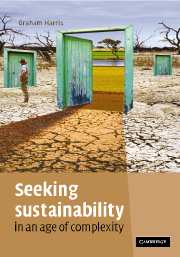Book contents
- Frontmatter
- Contents
- Acknowledgements
- 1 Preamble: the world we are in
- 2 Complexity and complex systems
- 3 New science, new tools, new challenges
- 4 The complexity of ecology
- 5 The generation of complexity
- 6 Micro-interactions and macro-constraints
- 7 A sense of place
- 8 Created landscapes and our changing sense of place
- 9 Catchment form and function
- 10 Catchment loads: ecosystem impacts
- 11 Change detection, monitoring and prediction
- 12 Evidence, uncertainty and risk
- 13 Modified landscapes: biodiversity
- 14 Function in fragmented landscapes
- 15 Environmental flows
- 16 Evidence for global change
- 17 Values and beliefs
- 18 Managing environmental, social and economic systems
- 19 Linking multiple capitals in a changing world
- 20 Community, capacity, collaboration and innovation
- 21 A new environmental paradigm
- 22 Emergent problems and emerging solutions: developing an ‘ecolophysics’?
- 23 Avoiding collapse
- Index
14 - Function in fragmented landscapes
Published online by Cambridge University Press: 21 March 2011
- Frontmatter
- Contents
- Acknowledgements
- 1 Preamble: the world we are in
- 2 Complexity and complex systems
- 3 New science, new tools, new challenges
- 4 The complexity of ecology
- 5 The generation of complexity
- 6 Micro-interactions and macro-constraints
- 7 A sense of place
- 8 Created landscapes and our changing sense of place
- 9 Catchment form and function
- 10 Catchment loads: ecosystem impacts
- 11 Change detection, monitoring and prediction
- 12 Evidence, uncertainty and risk
- 13 Modified landscapes: biodiversity
- 14 Function in fragmented landscapes
- 15 Environmental flows
- 16 Evidence for global change
- 17 Values and beliefs
- 18 Managing environmental, social and economic systems
- 19 Linking multiple capitals in a changing world
- 20 Community, capacity, collaboration and innovation
- 21 A new environmental paradigm
- 22 Emergent problems and emerging solutions: developing an ‘ecolophysics’?
- 23 Avoiding collapse
- Index
Summary
Restoration of agricultural landscapes, urban landscapes and infrastructure.
Much less work has been done on the effects of land use change and habitat fragmentation on processes in landscapes than on the spatial patterns of species. We do know that fragmentation compromises function and this allows water, salt and nutrients to be mobilised across partly cleared catchments. As might be expected, ecosystem function is better preserved in larger fragments. Simple models show that the landscape becomes dysfunctional and leaky after fragmentation, and the models reproduce the broad patterns observed in Australian catchments. It is becoming clear that what fragmentation and land use change does is to alter the original pattern of biophysical features and species in the landscape (which has contingent biological origins); in doing so, it reduces water and nutrient use efficiency. It appears that much of the small-scale pattern in landscapes is produced by self-organisation and SGC through local interactions, which result in an approach to something like maximum water and nutrient use efficiencies on the part of the whole. Agricultural development after clearing may increase the overall production of crops but at the cost of reduced overall water use efficiency. This is strongly reminiscent of the result discussed earlier that at about 50% reduction in coverage the relationships between pattern and process change from being dominated by reaction–diffusion relations (strong coupling) to one where the ability to find and colonise suitable habitat patches becomes the limiting factor (weaker coupling).
Information
- Type
- Chapter
- Information
- Seeking Sustainability in an Age of Complexity , pp. 189 - 203Publisher: Cambridge University PressPrint publication year: 2007
